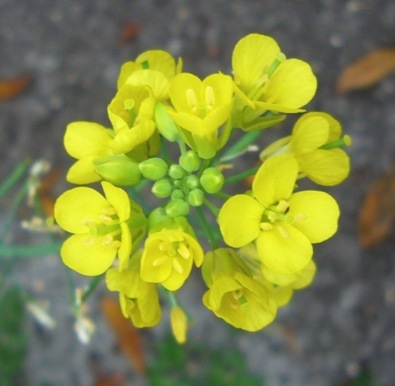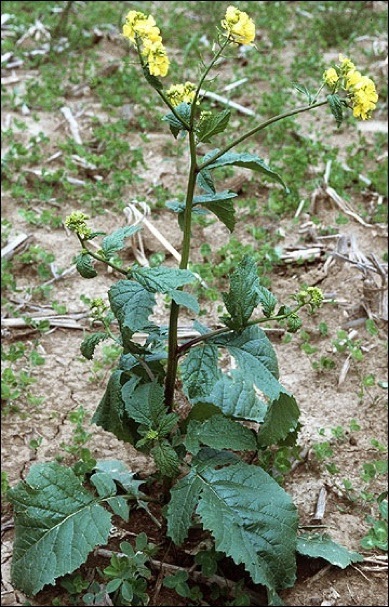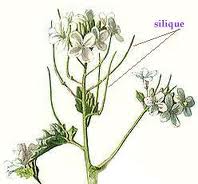Cutting the Wild Mustard: Brassica & Sinapis
Lorenzo’s Oil and Canola, Too
If you can’t find a wild mustard growing near you, you must be living in the middle of a desert ‘cause they even grow in the arctic circle. In fact, it’s among the few plants in Greenland and is even found near the magnetic north pole.
A native of Eurasia and cultivated for some 5,000 years, the Mustard — Brassica et alia, previously Sinapis et alia, or as the botanists write, spp. — came to North America in the 1700s and is as wide-spread and varied as possible. It usually blossoms in winter here in Florida and over Christmas I saw a patch in full bloom in a backyard, feeding honeybees. I would have brought some home for supper but couldn’t find the homeowner for permission to harvest. But that’s okay, there’s an orange grove near me that is starting to sprout mustards, so…
The word “mustard” comes from the dead Latin phrase “mustrum ardens” because the Romans put the peppery “burning” seed in wine must. Why? They watered down their wine. Perhaps mustard added flavor. Maybe they liked their wine peppery. Brassica is Latin for cabbage and Sinapis (sin-NAP-is) is Greek meaning mustard. In other words, it was correctly named in Greek but is now incorrectly named in Latin. That’s botanical progress. Modern Greeks call it sinapi. ( I think Latin is preferred over Greek because it is a dead language. One doesn’t have to learn to speak Latin to be considered a scholar of said…. which is kind of like being a celibate sex expert. )
While the table condiment mustard does indeed come from the mustard seed, the leaves, flowers, seed pods and roots are also edible. Mustards are in the same large family with cabbage, cauliflower, broccoli, turnips, kale, kohlrabi, wasabi, and others. The only problem is there are so many wild mustards its hard to tell which one you might have. They are all edible, but some are a little more edible than others. What that means is mustard greens I used to pick in Maine were fairly tender, and not strong when cooked. The mustard greens I pick here in Florida are much tougher and spicier. They have to be chopped up more and cooked longer, but they still are delicious if a bit toothy. The point is you have to experiment a little to find your preference with your particular mustard.
Young leaves can use used raw in salads, or cooked as a potherb. As the plant ages, it becomes strong and sometimes the leaves are too bitter to eat. Tender young seeds pods can be added to salads, but are peppery. If you are so inclined, you can make mustard out of the seeds, just grind them up and mix with vinegar, salt optional. Each plant can produces 2,000 to 3,500 seeds a season and the seeds can remain dormant underground for years.
Flower buds are also tasty when boiled. One nice touch is to add raw mustard flowers to your favorite vinegar to give it a little personalized pick-me-up — like the Roman wine, after all vinegar is just tarted up wine. The ratio is about half a cup of blossoms per pint of vinegar. Oh, the shape of the blossoms — like a Maltese cross — gave name to their family, Cruciferae, or cross-like. That’s the positive side of mustard, here is the negative side:
Many agricultural departments classify wild mustard as poisonous because if cattle eat too much of it they can get quite ill with stomach irritations — and they have more than one stomach to irritate. Humans aren’t the herbivores cattle are and we don’t tend to eat as much mustard, still some caution is advised. Many are allergic to mustard so if you’ve never eaten any, it is best to try only a little at first. Mustard is a bane to dairy cows because it can flavor the milk making it unsellable.
Mustard, also know as charlock, is also at the heart of an academic controversy representing trillions of dollars. Canola is a mustard seed oil, from the rape plant, a mustard species. The word Canola comes from “Canadian Oil Seed, Low-Acid” which was its experimental name. Canola is currently very popular and presented as a healthy oil. Some experts would disagree, at the forefront, Dr. Mary Enig, PhD., an oil expert who often champions coconut oil. Here is one place to read one side of the story: The Great Con-ola.
There is a constituent in the rape seed oil — erucic acid — that is toxic to people and many animals in any significant amount. It has to be refined out. That refining process involves heating and deodorizing which Enig says increases the amount of chemicals and transfats in Canola oil. In her view it is a barely tolerable seed oil in its natural state made more unhealthy by refining. One note though, erucic acid is helpful in the treatment of adrenoleukodystrophy, the wasting disease, and was the magic ingredient in Lorenzo’s oil. Does this mean Lorenzo could have been helped by eating the seeds of a local mustard plant? That’s an interesting question. Modified olive oil and rapeseed oil stopped the progression of his disease. Lorenzo was helped with the usually toxic erucic acid about the same time agribusiness was trying to produce an erucic-free rapeseed oil. Whether that oil is good for those of us who are healthy is a hotly debated issue. In it natural state rape seed oil when used for cooking can cause lung cancer.
In the 1980’s corn oil — which research consistently shows is high-octane cancer fuel — and soybean oil, heavy in unbalancing Omega 9’s — were coming under increasing criticism as being unhealthy. The search was on for a vegetable oil that had a supposedly good health profile. Rapeseed oil was a possibility but it had to be refined for mass consumption and the erucic acid removed. In the quarter century since what was once considered an oil fit for only industrial uses has become the household food oil of choice. There isn’t much human use to prove this modified version of rapeseed oil safe in the long term. None in fact. There are no long-term studies on human use because it has been assumed to be safe. Animal studies, however, implicate rapeseed oil in creating heart lesions, Vitamin E deficiency and stunted growth. Cattle growers refuse products with it. You may want to read up on Canola oil and consider its value to you.
Personally, I avoid Canola oil, preferring oils that were around in my grandparents’ day and avoiding all oils (and sugars or substitutes) discovered or made in the 1900s. I think the diabetes and obesity epidemics are directly caused by manufactured oils and high fructose corn syrup — that and the wrong advice to eat a high carbohydrate diet. My mottos are: Trust the cow, Not The Chemist, and, Stay Away From Doctors… They Make You Sick. I am not a health nut, but in the long run I think eating like our great grandparents may just be the best diet because it was proven over thousands of years to work. They ate real food. Today we tend to eat processed semi-food stuff, what I call technofood.
Off the soap box and back to the plant: When I was a kid, back in the Dark Ages, my father built our house with no plans for a lawn. Still, the graded area had to be covered with something so he spread hay chaff from the hay barn all over the area in the spring. That year — 1960 — we had two major crops grow there. First was a very healthy and happy small field of mustard plants, most of them reaching towards six feet tall. Following them was an equally lush growth of pigweed, Chinopodium album. We ate a lot of greens that year.
Green Deane’s “Itemized” Plant Profile
IDENTIFICATION: Flower: Four four petals NOT veined; Flowers tend to in clusters. Leaves: toothed, somewhat lobbed. Seed are in pods called siliques. The pod open straight down the middle to expose the seeds on both sides. Wild radish pods usually break into fragments. Can grow to six feet tall.
TIME OF YEAR: Springtime, or summer depending on where you live.
ENVIRONMENT: Well-drained soil, sandy to rich, old pastures, gardens, lawns, roadside.
METHOD OF PREPARATION: Leaves as potherb, seeds for spice or flavoring, can use flowers to flavor vinegar. Some young leaves can be used raw in salads. Try a little first.
Recipe by Pascal:
Take 3 part apple cider vinegar, 2 parts white wine, 1/2 clove garlic, a bit of California Bay Leaf and Italian Spices, red chili and voila! Oh…and a dash of sea salt as well per jar. Canning it for 15 minutes (water-bath canning).






Are there any dangerous look-alikes for the Wild Mustard and Radish?
If one looks close enough there are few look alikes. Generally said, no but I did cover the topic in part here because there is one plant you should avoid. I also cover it in part here.
A patch of it was growing around, and became as tall as, and was hiding my lilac. I figured it had to be useful for something. Thanks.
Can you eat/have you eaten Tower Mustard (Arabis glabra) in the same manner as other wild mustard? Specifically, are the seeds just as good as other wild mustard seeds? The leaves on the Tower Mustard are small and few, but it sure produces a large quantity of seed! I’m having trouble finding any evidence of regular use/consumption of these seeds by anyone online and wondered if you have any experience?
Your comment was posted man years ago, and even today I am having little luck finding an answer to this!
Although it is not formally listed there are not toxic members of the mustard family. Some are too strong to eat much of.
I cooked up a big pot of wild mustard greens yesterday. They were tender and delicious, like any mustard greens I have grown in my garden. I am in Central Florida. What has always worked best for me when picking greens is to pick clean (sand-free), tender leaves, and avoid picking any thick stems. Often I strip smaller leaves, several at a time, leaving the stems on the plant. Don’t pick the big leaves at the bottom of the plant. They will be sandy and more likely to be bitter. Don’t make extra work for yourself by picking sandy greens. Simmer them in a covered pot for about an hour (until tender) in about 3/4 – 1 inch of seasoned water (salt, pepper, and if you like it, add bacon fat), stirring occasionally, and checking the water. When they are nearly done, remove the cover to reduce the liquid, which is known as “pot likker” or “pot liquor.” Pot likker is nutritious and it is used for sopping cornbread or making soup. You can freeze cooked greens in ziploc bags or freezer containers to eat throughout the year. I also freeze pot likker to use when I make homemade soup.
Well written! Reader should remember the old aboriginal adage, “there is a reason why God put those nasty hairs on stems (under leaves) and thorns on plants” meaning, be careful, and eat in moderation. GOD must have warned for health reasons but also to ensure that THAT particular plant would not go out of extinction, thus, it is a valuable plant. How many people would eat mustard leaves covered in hair? Early spring was always the best option for collecting plants. Aging causes toxins…eventually…in many plants. Did the Romans use the wine mixture as an ointment for open sores? Possibly. The outer bark should be removed from the stems.
The bees are dying. One reason is that the queen is not allowed out to poo and parasites mite be attracted to the poo. Another reason, is ants. Old bee keepers before my time, which would be in the thirties, would apply mustard along the opening of the passageway to deter the ants. The idea was that the ant’s antlers would touch the mustard and give such an irritation that the ants would move on and/or out. I wonder how many ant hills are around mustard plant fields. It is an experiment worth investigating as perhaps more mustard plants around bee hives may (or may not) be helpful. Pass it on!
LOL! I’m living in the middle of the desert, and we get tons of blue mustard. Love it.
I found do many four petal yellow flowered plants in my garden. I had a fought that it must be edible but not sure of it. I cleaned garden half of it when doing that I regret to clean that. Thanks I tasted the flower first time it tastes good when consumes afterwards I felt light bitter taste in tongue . Thanks again
We live in Las Vegas (desert climate) and I have a hard time growing anything. So far I’ve managed some desert palm grass (which is now blooming with tall pink flowers) & Rosemary in direct sunlight, plus a few odds & ends in our little patches of dirt that sit under the awnings and never get direct sunlight. Sometimes I just toss seeds from jars of store-bought seeds from the spice department of the grocery store. I’m amazed at the pretty yellow flowers that have bloomed on the mustard seeds. Now they’re coming back every year.
I’ve found that the large leaves are good for cooking, however the stalk (part close to the base) in those large leaves (leaf removed) is very lush and crispy and not as bitter as the leaves, so a few of those ends on the stalks raw are great to munch on for a snack.
the whole flower bud (as it begins to sprout) i find similar in taste to broccoli)
also i’ve found mustard flowers that are white mostly.
i tend to collects buds of the plants also to cook as it encourages more leaves and flower stems.
it’s a wonderful plant thats very abundant.
Deane the recipe you posted, is that for pickling the seed pods as in the photo, or the leaves?
I’m in the desert too, in northern Baja California, Mexico and we have lots of mustard growing here. I was told it was black mustard, but I’m not sure how accurate that is.
Thanks Janet for posting that recipe for cooking the greens.
It can be used for either. Though with various seeds some times you can ferment them for three days or so, rinse, the put them in the fridge with some vinegar and a bit of sugar.
Often wondered edibility value. Tasted young buds/ florets and the weren’t bad. Didn’t know so I only tasted the . Thanks Green Deane
Thank you…been nibbling on this for years, but never took it seriously!!
I’m in!! 🙂